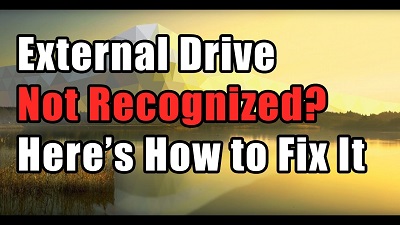External Hard Disk Not Detected
External hard disk not detected: While working on your computer there are chances that your computer doesn’t recognize your External Hard Drive after confirmation of successful connection as well. This issue may arise majorly when either your device driver is outdated or corrupted. These issues can be little difficult to handle and may take hours together and still you end up not getting the right solution to resolve the issue.
Now you may be thinking of the reasons that result in this error. Well, there are many of them that may give rise to this issue of – external hard drive not detected.
Table of Contents
Reasons for External Dard Drive Not Detected
- Hard drive fails
- USB port of the computer stops working.
- Hard drive driver gets outdated.
- Virus attack
Fortunately, there are solutions available for this issue and you can get your external hard drive functioning again.
You can try the methods given below to resolve the issue – External Hard Drive not being detected in Windows
5 Ways to Fix External Hard Disk Not Detected Issue
1. Running troubleshooter
The very first thing that you can think about doing is to run – Hardware and Device Troubleshooter & Windows USB Troubleshooter to check if it solves the issue.
It is an inbuilt tool checks the USB/hardware attached to your PC to identify if there are any issues and fix them if found any on its own.
You can find these tools by heading to the start search and then go to troubleshooters from Windows 10 troubleshooting page.
2. Change the port
Firstly try unplugging your external hard drive from your port and then inserting it to a different port. In case this works for you then chances are that the port where you plugged the external drive earlier is dead. Also, you can make use of a different USB to check. If that works good in both the ports then may be your USB is not faulty.
3. Update/Reinstall device driver
In order to accomplish this process follow the steps given below
- Head to – Device Manager (pres Win+R) simultaneously
- It will open – Run dialog box
- Enter – msc.
- Now, look through the list to find the external device
- In case you see a yellow/red sign that appears next to the driver then just right click its name and choose – Update Driver Software
In case you come across any ‘Unknown device’ make sure you continue to update that as well. Choose – search automatically for update driver software and just follow the instructions given on your screen to complete the process.
In case the above process doesn’t work for you simply uninstall the drive and re-install it.
4. Disable the setting – USB selective suspend
In case the methods elaborated above do not give you the solution to the issue then try to disable the USB selective suspend setting. Here you can learn to do it.
- Via control panel open – Power Options
- Go to – Additional power settings
- Now, click this option – ‘Change plan settings’ besides your preferred power plan
- Below USB settings go to – ‘Change advanced power settings’ and look for – USB selective suspend setting and then just disable it.
- Click on Apply and then Exit
5. Build new partition on removable drive
If this is the first time you are connecting the hard drive to your computer and never done it before then your drive will not shop up as there are no partitions created on it.
This will be detected by Windows Disk Management tool. Now, try to check if – Disk Management tool is able to find your external hard drive.
- Open – Disk Management tool
- Head to – Search and type – msc
- Press- Enter
In case the external drive can be discovered in the list – Disk Management window, just format it so that it detects the very next time you attach your computer to it.
In case you find that your drive is not partitioned/not allocated, then just format it and create altogether a new partition.
The above methods will certainly work for you and you won’t see the error again and you can see external drive functioning properly.
Follow Us On:
